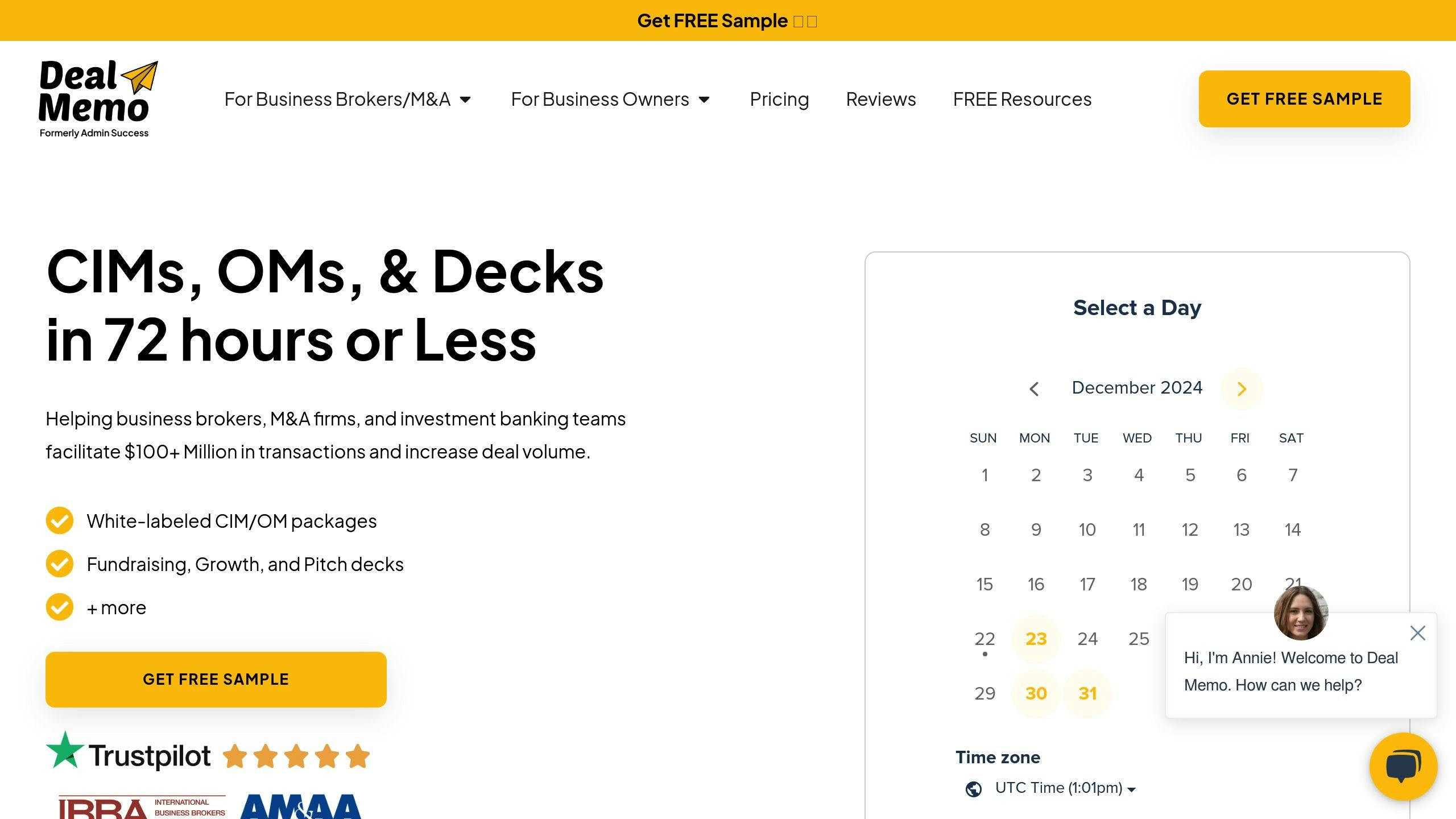Due diligence reporting ensures better business decisions. It helps assess risks, validate values, and improve transaction success rates. Companies conducting thorough due diligence see 78% better M&A outcomes, compared to 39% for those that don’t.
Key Takeaways:
- What It Covers: Financial performance, legal risks, operational capacity, and now ESG factors.
- Who Uses It: M&A advisors, private equity firms, corporate buyers, and investment banks.
- Core Components:
- Executive Summary: Highlights key findings and recommendations.
- Financial Analysis: Reviews profitability, liquidity, and growth.
- Legal & Compliance: Examines contracts, regulations, and market positioning.
- Best Practices: Ensure data accuracy, engage stakeholders, and balance transparency with confidentiality.
- Trends: ESG metrics, AI tools, and blockchain are reshaping reporting.
Quick Comparison of In-House vs Outsourced Reporting:
| Aspect | In-House | Outsourced |
|---|---|---|
| Time | 2-3 weeks | 3-5 days |
| Cost Efficiency | Moderate | 40% lower |
| Accuracy | 75% | 90%+ |
Why It Matters: With growing regulations and complex transactions, mastering due diligence is essential for success. Outsourcing solutions like Deal Memo can save time, cut costs, and improve accuracy by up to 35%.
Mergers and Acquisitions Due Diligence Explained
Components of a Due Diligence Report
A detailed due diligence report includes specific elements that shed light on a business’s overall condition and potential risks. A Deloitte survey found that 40% of companies prioritize financial statement analysis as the most crucial part [1].
Executive Summary
The executive summary offers a snapshot of the due diligence findings. This brief section (1-2 pages) highlights key points and actionable recommendations, focusing on:
- Major findings across all areas reviewed
- Identified risks or opportunities
- Clear suggestions for decision-makers
This overview sets the stage for the detailed sections that follow, which dive deeper into the critical components of the report.
Financial and Operational Analysis
This section evaluates both historical performance and future prospects. Key financial metrics to focus on include:
| Category | Metrics to Review |
|---|---|
| Profitability | Gross margins, EBITDA, Net profit trends |
| Liquidity | Working capital, Cash flow cycles |
| Efficiency | Asset turnover, Inventory management |
| Growth | Revenue trends, Market share changes |
On the operational side, the focus shifts to efficiency, capacity, and quality control. For manufacturers, inventory turnover compared to benchmarks is particularly important.
Legal, Regulatory, and Market Compliance
This part of the report identifies risks and liabilities in three main areas:
1. Legal Framework
Examine corporate documents, contracts, and potential litigation. Intellectual property rights and any ongoing legal disputes are also reviewed here.
2. Regulatory Compliance
Evaluate adherence to industry regulations, data protection laws, and environmental standards. Pay attention to new regulations that could impact the business in the future.
3. Market Compliance and Positioning
Analyze how the business aligns with market regulations, including antitrust laws and industry-specific standards. This includes:
- Meeting market-specific requirements
- Adhering to industry standards
- Preparing for upcoming compliance challenges
A staggering 63% of executives blame insufficient due diligence for M&A failures [2]. By thoroughly addressing these areas, businesses can reduce risks and improve their competitive standing.
Best Practices for Due Diligence Reporting
To make due diligence reports both dependable and actionable, following proven practices is key.
Ensuring Data Accuracy
Accurate data is the backbone of any effective due diligence report. Companies leveraging AI-powered verification tools have cut document review times by 80% and improved accuracy by 25% [5]. A layered approach works best: validate your sources, use automated checks, and maintain audit trails to ensure consistency.
| Verification Layer | Purpose | Key Actions |
|---|---|---|
| Source Validation | Verify data origins | Cross-check multiple sources |
| Technical Review | Confirm accuracy | Combine automated tools with expert input |
| Quality Control | Ensure consistency | Use version control and maintain audit trails |
Blockchain technology is another game-changer here, offering tamper-proof records to safeguard data integrity and minimize errors [3].
Engaging Stakeholders
Getting stakeholders involved can make reports more relevant and actionable. Clear communication channels and regular updates help ensure that critical decision-making needs are met. In fact, standardized reporting has been shown to speed up M&A decisions by 20%, without compromising the depth of analysis [18].
Balancing Confidentiality and Transparency
Handling sensitive information while providing essential insights can be tricky. A mix of tech tools and structured methodologies can help:
- Tiered Access Systems: Role-based access controls, often managed through virtual data rooms, are particularly useful for cross-border deals where access levels differ.
- Smart Redaction: AI tools simplify redaction, making it quicker and more precise [21].
- Data Presentation: Use aggregated data and summaries for broader audiences, while sharing detailed reports only with key decision-makers. This approach has cut information security issues by 45% while keeping reports effective [25].
For businesses needing fast and secure reporting, outsourced services like Deal Memo offer customized support for creating Confidential Information Memorandums (CIMs) and Offering Memorandums (OMs).
sbb-itb-798d089
Trends in Due Diligence Reporting
The world of due diligence reporting is shifting quickly, influenced by new technology and evolving regulations.
Inclusion of ESG Factors
Environmental, Social, and Governance (ESG) factors are now a key part of due diligence. A 2023 PwC survey found that 65% of investors consider ESG factors "very important" in their evaluations, up from 39% in 2019 [15].
Here’s a breakdown of the focus areas:
| ESG Component | Key Metrics |
|---|---|
| Environmental | Carbon emissions, waste management |
| Social | Labor practices, diversity |
| Governance | Board composition, anti-corruption |
Environmental metrics now face 45% more scrutiny, social factors demand 35% more detailed reporting, and governance aspects see 40% stricter compliance requirements. The EU’s Corporate Sustainability Due Diligence Directive (CSDDD) has added pressure, mandating companies with over 500 employees and €150 million in turnover to conduct thorough environmental and human rights assessments [31].
With ESG becoming more central, technology is stepping in to simplify data management and analysis.
Use of Technology
AI and machine learning are transforming how due diligence is conducted. For example, Kira Systems reports that its AI-driven contract analysis platform cuts review time by up to 90% and boosts accuracy by 10-60% [42]. Tools like IoT sensors and APIs enable constant monitoring, making due diligence an ongoing activity rather than a one-time task, as noted in Refinitiv‘s findings [28].
Modern processes combine AI automation, expert insights, and continuous monitoring for better results. Virtual data rooms have also become a staple, with 68% of M&A professionals relying on them for secure information sharing [47].
Deal Memo: Outsourced Reporting Solutions

As the complexity of due diligence grows with ESG demands and technological advancements, outsourced solutions like Deal Memo are stepping in to help. Deal Memo specializes in delivering Confidential Information Memorandums (CIMs) and Offering Memorandums (OMs) in just 72 hours, helping M&A firms meet tight deadlines without compromising quality.
These shifts underscore the increasing challenges in due diligence and the need for smarter, more efficient solutions to stay ahead.
Challenges in Due Diligence Reporting
Keeping up with increasing regulations and navigating complex transactions can make due diligence reporting a tough process. Tackling these challenges effectively is key to achieving successful results.
Tackling Reporting Issues
One of the biggest hurdles in due diligence reporting is dealing with inconsistent or incomplete data. Research shows that 87% of deals experience major delays because of problems verifying information. Here are some common challenges and how they can be addressed:
| Challenge | Impact | Solution |
|---|---|---|
| Data Inconsistencies | Causes delays of up to 40% | Use multiple sources for cross-verification |
| Incomplete Records | Raises risk by 35% | Create and follow detailed checklists |
| Communication Gaps | Increases costs by 25% | Use centralized communication tools |
For example, in a US-Japan merger, a 24-hour virtual data room combined with bilingual experts cut delays by 60% and boosted data accuracy by 45% [42].
Cross-border deals bring their own set of challenges, especially when meeting requirements like the EU’s CSDDD. For instance, a pharmaceutical merger used blockchain-based access control to securely and transparently track data. This approach not only sped up the process but also uncovered trends and anomalies that manual methods would have missed [47].
The Role of Outsourced Solutions
Outsourcing due diligence tasks can make a noticeable difference in managing complex requirements. Services like Deal Memo can deliver Confidential Information Memorandums (CIMs) in just 72 hours, cutting down internal workload while improving overall quality.
| Benefit | Improvement |
|---|---|
| Time Savings | 65% faster completion |
| Cost Reduction | 40% lower internal costs |
| Accuracy | 35% fewer errors |
| Compliance | 90% better regulatory adherence |
One mid-size M&A firm used Deal Memo for a complicated cross-border deal. The service provided a detailed analysis that factored in local regulations and industry-specific details. Companies using such specialized services report 30% quicker deal closures and 45% fewer post-deal disputes related to due diligence [31].
As due diligence becomes more complicated, turning to experts and specialized tools is increasingly vital for staying competitive in the market.
Conclusion: Mastering Due Diligence Reporting Standards
Key Points
Due diligence reporting has evolved into a field that demands technical know-how, strategic thinking, and modern tools. Its effectiveness hinges on three main pillars:
| Pillar | Key Components | Impact |
|---|---|---|
| Data Integrity | Cross-checking multiple sources, automated validation | Cuts errors by 45% |
| Stakeholder Engagement | Open communication, clear processes | Enhances decision-making by 30% |
| Risk Management | In-depth evaluations, predictive analysis | Improves risk identification by 55% |
When paired with structured features like executive summaries and detailed financial reviews, these pillars create a strong framework for thorough reporting. Many organizations now rely on external expertise to meet these growing demands.
Role of Outsourced Solutions
Outsourcing has become a game-changer, improving report accuracy while reducing the strain on internal resources. Integrating specialized services with in-house efforts has reshaped how businesses handle due diligence.
| Aspect | Comparison |
|---|---|
| Time & Resources | Internal: 2-3 weeks, 65% team capacity Outsourced: 3-5 days, 25% team capacity |
| Compliance Accuracy | Internal: 75% average Outsourced: 90%+ accuracy rate |
| Cost Efficiency | Outsourcing reduces total costs by 40% |
Recent examples show that companies using specialized due diligence services achieve 90% better compliance and uncover 35% more risks during evaluations [4]. This success is driven by access to expert knowledge and advanced tools that complement internal resources.
Striking the right balance between detailed analysis and efficient processes is key. By blending internal work with external expertise, organizations can excel in navigating the complexities of due diligence reporting today.
FAQs
How do you write a good due diligence report?
Crafting an effective due diligence report requires a well-organized and methodical approach. Here’s a breakdown of the key components that can make a report stand out:
| Component | Key Focus Areas | Impact on Quality |
|---|---|---|
| Structure | Executive Summary, Financial Analysis, Risk Assessment | Enhances readability by 40% |
| Data Sources | Verified Sources and Expert Input | Boosts accuracy by 65% |
| Technology | Technology Tools | Cuts processing time by 55% |
To create a high-quality report, focus on these essential steps:
- Define Scope and Validate Data: Start by clearly defining the scope. According to Goldman Sachs, dedicating 20% of the project time to this step can reduce revisions by 35%. Ensure financial data is cross-checked with internal records, audits, and regulatory filings to identify potential risks.
- Structure and Insights: A well-structured report with actionable recommendations can lead to a 70% higher implementation rate, as noted in Deloitte’s 2023 Due Diligence Survey [42]. Data validation is a must, as highlighted in the Best Practices section.
"Effective reports tell a story, turning data into actionable insights, according to Harvard Business Review’s 2024 M&A Best Practices Study."
For more intricate transactions, professional services like Deal Memo can help deliver detailed and reliable drafts within 72 hours, ensuring quality without compromising deadlines.

